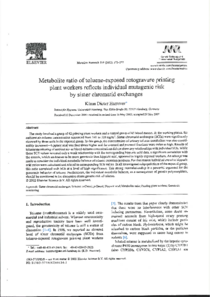Metabolite ratio of toluene-exposed rotogravure printing plant workers reflects individual mutagenic risk by sister chromatid exchanges

Mutation Research. Fundamental and Molecular Mechanisms of Mutagenesis
2002
519
171-177
biomarker ; exposure ; genetic screening ; individual susceptibility ; mutagenicity tests ; printing worker ; toluene
Medicine - Toxicology - Health
English
Bibliogr.
"The study involved a group of 42 printing plant workers and a control group of 45 blood donors. At the working places, the ambient air-toluene concentration amounted from 141 to 328 mg/m(3). Sister chromatid exchanges (SCEs) were significantly elevated by three units in the exposed group. In this group, the concentration of urinary toluene metabolites was also considerably increased-hippuric acid was four times higher and the o-cresol and p-cresol fractions were twice as high. Results of toluene monitoring of ambient air- or blood-toluene concentrations did not show any relationships with individual SCE. While these SCE values revealed only a weak relationship with the corresponding hippuric acid data, a significant correlation with the cresols, which are known to be more genotoxic than hippuric acid, appeared in highly exposed workers. An attempt was made to consider the individual metabolic balance of toluene excretion products. For that reason individual cresol to hippuric acid ratios were calculated and related to corresponding SCE values. In all investigated subpopulations of the exposed group, this ratio correlated with SCE at a level of high significance. This strong interrelationship is a powerful argument for the genotoxic behavior of toluene. Furthermore, the individual metabolic balance, as a consequence of genetic polymorphism, should be considered in the discussion about genetic risk of toluene."
Digital
The ETUI is co-funded by the European Union. Views and opinions expressed are however those of the author(s) only and do not necessarily reflect those of the European Union or the ETUI.